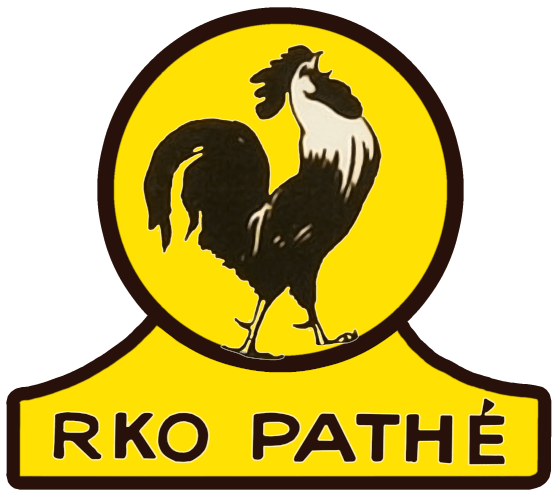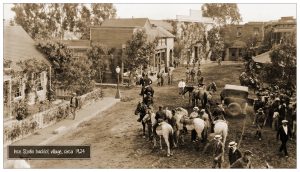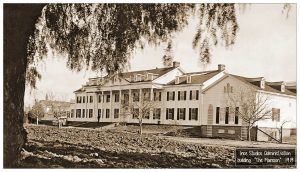9336 Washington Blvd
Culver City's Forgotten Major Studio
Built by Mega Mogul Thomas H. Ince in 1918
Also owned by Cecil B. DeMille, Pathé, RKO, David O. Selznick, Desilu, and Sony.
Today it is the home of Amazon Studios.

Thomas H. Ince Studio
9336 Washington Blvd., Culver City
1918-1925
By the time Thomas H. Ince bought this property from Harry Culver, he was already one of the biggest producers in the business with several classics and masterpieces in the can. This was Ince's 5th studio as a producer and his 3rd as an owner. There were no more powerful producers in "Hollywood" than Thomas Harper Ince.
Each of his other studios was considered the most modern and complete in the business at the time they were built. This third studio, known as Thomas Ince Studio, was no different. For its day it was the most complete and up-to-date ever built, even more modern than the one he built up the block a few years earlier (that eventually would become the industry powerhouse, Metro Goldwyn Mayer).
Until he built this studio, Thomas Ince worked with business partners. He always felt exploited by them, making them richer than they deserved. So, after negotiating a whale of a buyout with his partners up the road at his Triangle studio, he vowed he would have no more partners. So Ince began looking for a piece of land he could buy and build his own studio, being his own boss. His only partner was his wife, Nell.
Thomas Ince Builds his third studio
Ince found the perfect property. It was under a mile away from his old studio. Ince arranged a lease of 11 acres (some sources put it at 9.5 acres) from his old pal, Harry Culver, who agreed to put up the money Ince needed to build a new studio. The original studio footprint. covered only 6.5 acres of the 11, and was built by one of the big studio contractors in the industry, Milwaukee Building Company, who built many of Hollywood's top studios. While waiting for the studio to be completed Ince temporarily located the company at the old Biograph Studio in downtown L.A. at a location that today is buried underneath the Los Angeles Convention Center.
The centerpiece of the new studio was a mansion-like administration building built in the vision of George Washington's Mt. Vernon home. This building's exterior, even after many remodelings over the next 100 years, continues to act as the lot's main admin building. It is now a historical place and can never be torn down.
In the original construction, the lot had two main stages, the "daylight" stages, which were oriented on an angle, just like the five original stages he built up the block at the old Ince -Triangle studio. Their orientation made them face the south, so the glass-enclosed stages could take full advantage of the sun for illuminating the sets naturally with lighting being used supplementally and for night shooting.
The land deal closed in June 1918, construction of 18 buildings, began in earnest in July at a cost of somewhere near $200,000. By Christmas, even though construction was not complete, production began. January 4, 1919 opening ceremonies were held.
It didn't take long for Ince to fill out the 6.5 acres with more stages and support building, and a small backlot. Construction continued at a frenzied pace. Even though a third daylight stage was proposed behind the first two, instead Ince built the studio's first "dark" stage (built without glass walls, to be used only with artificial light) beginning construction in 1919 and completing it in 1920. Prop buildings, carpentry shops, cutting rooms, and more were quickly added. They even put in a swimming pool. He was one of the first producers to build a film processing lab on the studio property to reduce the time between filming, editing, and release.
Ince virtually invented the "studio system," streamlining all the processes involved in movie making, consolidating all the processes within easy walking distance. He invented the roles of the producer and production manager, giving him the ability to manage many simultaneous projects, instead of doing a single film at a time.
Like other studio owners of the day, Ince leased out offices and stage to independent producers while he wasn't using them, to keep up cash flow.
Associated Producers, Inc., Ince's distribution company
 The major studios, Famous Players-Lasky, Universal, Goldwyn, Metro, and a few others, had advantages that the independents didn't. They owned their own distribution and exhibition channels. Though Thomas Ince was one of the largest (perhaps the largest) independent producer in the business, he was still dependent on others for getting their movies out to the public. In an attempt to combat that, in 1919 he formed a distribution company, Associated Producers, and invited other independents to invest in the channel. Eventually, Ince's partners sold their shares to First National, a growing distribution/production company. First National was a conglomerate of theater owners who wanted better quality and control over movies for their theaters. Now, as Associated's major shareholder, First National simply cut off Ince and forced him into a position of distributing through First National.
The major studios, Famous Players-Lasky, Universal, Goldwyn, Metro, and a few others, had advantages that the independents didn't. They owned their own distribution and exhibition channels. Though Thomas Ince was one of the largest (perhaps the largest) independent producer in the business, he was still dependent on others for getting their movies out to the public. In an attempt to combat that, in 1919 he formed a distribution company, Associated Producers, and invited other independents to invest in the channel. Eventually, Ince's partners sold their shares to First National, a growing distribution/production company. First National was a conglomerate of theater owners who wanted better quality and control over movies for their theaters. Now, as Associated's major shareholder, First National simply cut off Ince and forced him into a position of distributing through First National.
Ince the Movie Mogul
The number of reigning power brokers in the movie business was very few. Adolph Zukor of Paramount (then called Famous Players-Lasky), Carl Laemmle of Universal, Goldwyn (then called Goldfish), Griffith, Sennett. and DeMille. William Fox was just coming into his own. Later would come Marcus Loew (owner of Metro), The Cohn Brother (Columbia), and the Warner Brothers. The original major moguls and companies, Selig, Lubin, Biograph, Vitagraph, Essanay, Kalem, American Film, and others were gone or close to gone. Louis B. Mayer was still just a minor producer until the mid-20s. Lewis J. Selznick had many ups and downs and his son, David O. Selznick, was just a child. Walt Disney wasn't a blip yet. RKO hadn't been formed, 20th Century was a very minor player.
Thomas Ince, on the other hand, was one of the big 4 or 5 producers, with all the power that brought. He created the studio system, the studio head that hired other producers and supervised dozens of simultaneous productions. He created 3 state-of-the-art studios. He hired big stars and created big movies.
Untimely Death
Had Ince not died in November of 1924, he would be remembered the same way we remember those other names. However, there is no doubt Thomas Harper Ince was at the top of the business and his place in film history is solid and secure.
Thomas Ince died
under mysterious circumstances

1924 seemed a year like any other. Business was good, family life was good. Everyone loved Thomas Ince. Ince was a happy man and the world was at his fingertips. By the end of the year, however, it would all be turned upside down. On November 19, 1924, Thomas Harper Ince would die mysteriously while cruising with other motion picture people on board William Randolph Hearst's yacht, The Oneida. Read more of the details by going to Thomas Ince's profile page.
After her husband's death in November of 1924, Nell Ince did her very best to keep the company afloat. She seemed to have the right business mind and the disposition for it, but without the company's spiritual leader, it quickly lost its momentum. Finally, in mid-1925, Mrs. Ince shut down production, wrapped up current productions, and began to rent out stages and facilities, and looked for a buyer for her husband's prized possession.
In 1913 Cecil B. DeMille became one of the founding members (along with Jesse L. Lasky and Sam Goldwyn) of the Jesse Lasky Feature Play Company. He produced and directed for them for twelve years, but was never a partner in the company. He was strictly an employee.
DeMille did manage to parlay his position, however, into a partnership in the real estate the company built the studio on. Additionally, he bought outright the real estate parcel to the south, to where the company quickly expanded. DeMille became a landlord of the studio. Though he didn't own the company or the studio, he did own the real estate the studio sat on. The company merged with Adolph Zukor's Famous Players Film Company forming Famous Players-Lasky, which would later become the behemoth Paramount Pictures.
DeMille directed Hollywood's first feature-length film (The Squaw Man, 1913), and spectacles like The Ten Commandments. He was known for his grand spectacle movies that people flocked to see and made lots of money...for the company's owners
Cecil B. DeMille, one of the industry's premier directors. But DeMille was not satisfied with being an employee. He wanted ownership. Zukor, the company's majority partner, would not let DeMille in. On January 13, 1925, he left the company taking his best years with him and leaving Famous Players-Lasky without its most productive director.
DeMille began looking for a studio to buy. Naturally, he turned his attention to the Ince property in Culver City...to the great relief of Nell Ince. It was no secret that Mrs. Ince was struggling to keep he husband's gem alive and profitable. It seemed a marriage made in heaven.
In February of 1925 ownership of Thomas Ince Studio passed into the hands of Cecil B. DeMille. In addition to the studio purchase, DeMille started his production company, DeMille Productions.
DeMille forms PDC
Through a very complex set of transactions, the studio changed names a bunch of times. Early in his ownership, in 1925, DeMille found investors and started a new company: Producers Distributing Corp. Its purpose was to provide distribution for all the films that came out of the studio. Part of the deal was that DeMille would be the majority partner, and the studio would be under the ownership of PDC, the new company. It would still be called DeMille Studio. DeMille Productions would continue as DeMille's personal production company, making all his films under this name (for years to come). It is rumored that the venerable Pathé Company was one of PDC's silent partners (I await verification). PDC was closed in 1927 after distributing more than 100 films.
DeMille begins to rebuild.
There was nothing wrong with the Ince plant except that the industry was moving very fast. DeMille, realizing that much of the studio was outdated began an aggressive rebuilding project. Glass stages were being replaced all over Hollywood with artificially lit "dark" stages. DeMille removed nearly everything except the mansion, Stage 3 (the dark stage), and, of course, the pool. He tore down Stages 1 and 2 and built a larger stage in their place. With no need of the sun to light it, he reoriented all the stages, saving space and giving him more room to put other buildings. He also began filling out the remainder of the 11 acres.
The "40 Acres" Backlot
Behind the main lot to the east, DeMille found a parcel of bare land. As the main lot no longer had room for outdoor sets, he needed a place to build "Old Jerusalem" sts for his epic film The King of Kings. This would be a great place to build the magnificent sets DeMille had become famous for, so in February 1926 DeMille signed a 4-year lease for 28.5 acres at a cost of $10,000.
Later the backlot would take on a life of its own, becoming one of the most famous backlots in Hollywood. It would become known as "The 40 Acres" (the nickname coming during the RKO era), even though it never occupied exactly 40 acres). Apparently, there were originally 26 acres (or 29, depending on who you are talking to) to the north of Ballona Creek and 10 acres to the south of the creek which were later added to the backlot.
The "40 Acres" was the sight of one of DeMille's "masterpieces," 1927's King of Kings. Also shot at the "40 Acres" was RKO's King King, Selznick's Gone with the Wind, where he built the Tara mansion and the Atlanta train depot, Orson Welles' Citizen Kane, Desilu's The Andy Griffith Show, and the original Star Trek, and many, many other classic films and shows.
PDC
Producers Distributing Corp.
click to enlarge
Related Pages:
Read More:

Pathé-DeMille Studio
9336 Washington Blvd., Culver City
1928-1931

RKO-Pathé Studio
9336 Washington Blvd., Culver City
1931-1935

RKO Studio
9336 Washington Blvd., Culver City
1929-1931
Up to this point in the industry, and here at the studio, most companies were owned by individuals or partnerships. However, a shift was beginning, as in greater capitalistic America. Corporate entities were being formed. Conglomerates made up of a bunch of companies and individuals all of whom had stock in the new entities. The DeMille Studio, and its associated companies, were a prime example of this new phenomenon.
These three studio entities must be seen here, at Thomas Ince's studio, in one breath, as their histories all come together here and at several other associated Hollywood and New York studios. The names and companies were intertwined at this spot for decades.
A confusion of ownership and company names.
The Players:
- Cecil B. DeMille. One of the great producer/directors who comes to the table with a studio large, modern.
- PDC. DeMille's distribution Company.
- Pathé Frères. One of th eworld's largest production companies.
- FBO (Film Box Office). A distribution company owned by Joseph P. Kennedy, who owned an old Hollywood studio.
- Keith-Albee-Orpheum (KAO) a chain of theaters that converted from Vaudeville to movies.
- RCA (Radio Corp. of America) controlled by David Sarnoff. Brought a new sound on film technology to the group.
- Metropolitan Studios. A small studio owned by the Christie Brothers, ripe for the transition of talkies.
- Howard Hughs. Enuff said.
Pathé Frères
In 1900 Pathé Frères was the largest and most successful film studio in the world. Based in Paris, in 1904, it launched an American subsidiary, Pathé Company, based in New York to produce and distribute movies for the American market. In 1914 they built a short-lived studio in Jersey City, NJ. but ceased American production very quickly and reformed into Pathé Exchange to distribute the films of other production companies. Pathé Exchange was purchased by Merrill Lynch.
DeMille Productions
PDC (Producers Distributing Corporation)
In 1927 distribution powerhouse Pathé Exchange would buy into DeMille's Producers Distributing Corporation becoming the majority owner and again putting a bunch of money in DeMille's pocket (a rumor suggests that Pathé was already a PDC investor and they simply bought out the remaining shares. I await verification.). As PDC owned the studio, its ownership would pass to Pathé. The new studio ownership partnership company would be called Pathé-DeMille but the studio itself would still be knwon as, DeMille Studio. DeMille Productions would still be DeMille's separate, personal production company, based at the Pathé-DeMille Studio. PDC would continue, in a minor way, distributing pictures until 1929, and parent company Pathé Exchange would base its West Coast operation at the studio.
FBO (Film Box Office)
Keith-Albee-Orpheum (KAO)
Enter the picture Keith-Albee-Orpheum (a powerful movie exhibition company) who formed a partnership with DeMille Productions, and PDC to buy another studio in Hollywood, Metropolitan Studio on Santa Monica Blvd, from the Christie Brothers, who moved there from their original home on Sunset. The studio was tooling up for the coming sound era, and the new partnership wanted in on some of that action. DeMille was now partnered in two studios, while still operating DeMille Productions as his producing company.
RCA Company (Radio Corporation of America)
Of all the companies this is the only one who is still around today.
Meanwhile, Keith-Albee-Orpheum teamed with David Sarnoff's RCA Company to form a new company, RKO in 1928. They bought the FBO Studio at Melrose and Gower in Hollywood. In 1929 RKO bought the Pathé-DeMille Studio from DeMille, PDC, and Pathé, changing its name (again) to RKO-Pathé (to differentiate it from the main studio, RKO Gower).
MGM
In 1929, no longer the owner of the studio that no longer bore his name, he moved his DeMille Productions down the block to MGM, and rented space from his old rival, Louis B. Mayer.
Thus ended Cecil B. DeMille's involvement in the grand studio built by Thomas Ince.
1923, after coming under the control of Merrill Lynch, Pathé Exchange was re-incorporated to American Pathé. In 1927 Joe Kennedy's Film Booking Office bought a struggling American Pathé and merged with the Keith-Albee-Orpheum theater chain
David Sarnoff's RCA Corp. arranged a merger in1928 of (and bought a controlling interest in) Joe Kennedy's Film Booking Office (film studio and distributor), American Pathe, and DeMille's Producers Distributing Corp. Talkies were coming onto their own, and Sarnoff needed a market for RCA's newly formed film sound system. Forming his own movie studio, RKO Radio Pictures, was his answer to that while he searched out other markets.

































